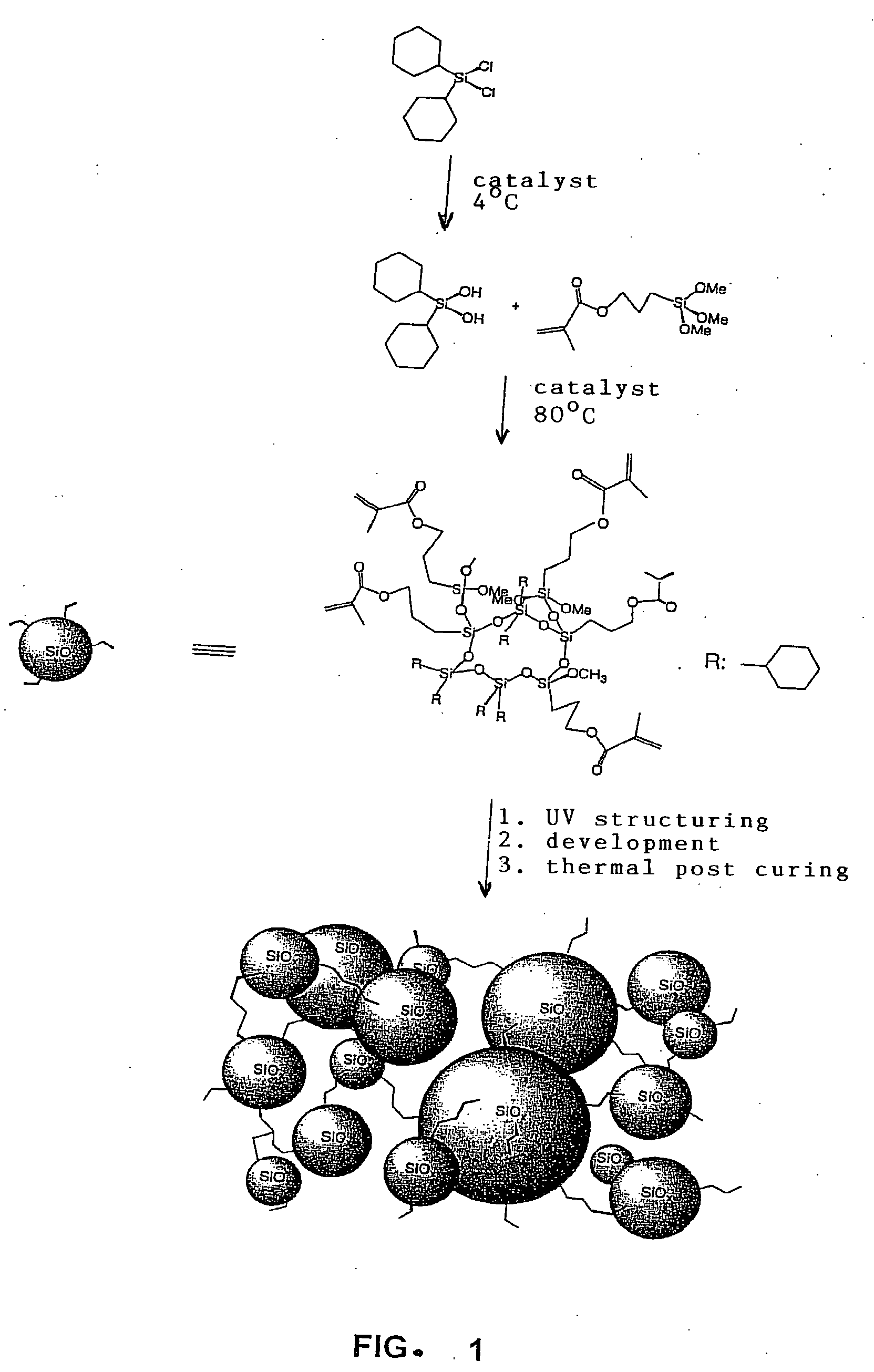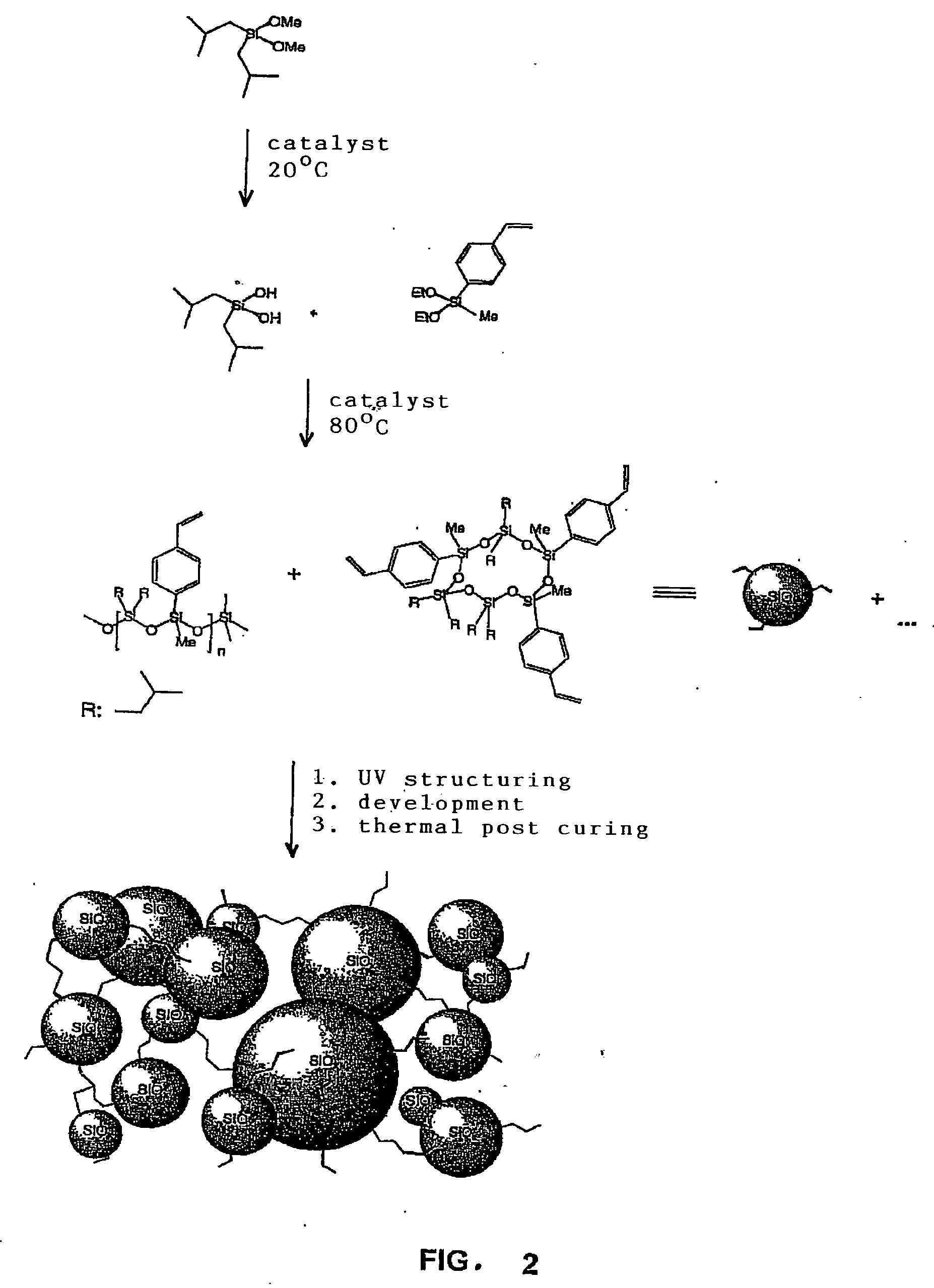Silane-based Resins That Can Be Photochemically And/or Thermally Structured, Single-step Method for Their Production, Parent Compounds and Production Methods That Can Be Used for Said Resins
a technology of silane-based resins and photochemical and/or thermal structure, applied in the field of silane resins, can solve the problem that secondary reactions cannot be excluded, and achieve the effect of reliable and reproducible yield
- Summary
- Abstract
- Description
- Claims
- Application Information
AI Technical Summary
Benefits of technology
Problems solved by technology
Method used
Image
Examples
example 1
Diisobutyl Silanediol
[0027]reaction equation: (C4H9)2Si(OCH3)2+H2O→(C4H9)2Si(OH)2+2 HOCH3 starting components:
(1) diisobutyl dimethoxy silane5.11 g (0.025 mol)(2) water0.90 g (0.050 mol)(3) isopropanol0.60 g
[0028]The components (1)-(3) are placed into a vessel at room temperature. Subsequently, approximately 3.0 g of an 0.1 n HCl solution are added dropwise until the pH drops to 4.5. A careful pH control is required here. The pH increases continuously (5-6) so that approximately an additional amount of 0.75 g of an 0.1 n HCl solution is added until the pH remains constant at 4. The mixture is stirred at room temperature for one day until a white precipitate forms. In order to dissolve the precipitate, approximately 14 ml diethyl ether are added; subsequently, approximately 15 ml water and 5 ml NaOH (pH 8). The two phases are then separated in a separating funnel; the aqueous phase is then extracted with diethyl ether (2×10 ml) and the organic phases are combined and subsequently was...
example 2
Dicyclohexyl Silanediol
[0032]
(1) dicyclohexyl dichloro silane50.7 g (0.19 mol)(2) tertiary butylmethylether 260 ml(3) triethylamine39.6 g (0.39 mol)(4) water7.60 g (0.42 mol)(5) tertiary butylmethylether 600 ml(6) acetone 60 ml(7) triethylamine1.64 g (0.02 mol)(8) pentane 560 ml
[0033]The components (3)-(6) are placed into a vessel and precooled to 4° C., and, subsequently, the mixture of (1) and (2) also precooled to 4° C., is slowly added in a dropwise fashion within 2.5 hours. The mixture is stirred for further 3 hours at 4° C. Since the pH value drops to 5.5, additional (7) is added, and the mixture is stirred over night at room temperature (RT). The precipitate is filtered off and the residue is washed with (2). Most of the solvent (˜90%) in the filtrate is distilled off (at 40° C.). To the residue, (8) is added and a precipitate is formed that is filtered off, washed with (8), and subsequently dried in a desiccator. The yield of the pure product was between 68, 87, and 93% (fi...
example 3
Diisopropyl Silanediol
[0034]reaction equation: (C3H7)2SiCl2+H2O→(C3H7)2Si(OH)2+2 HCl starting components:
(1) diisopropyl dichloro silane4.26 g (0.02 mol)(2) diethylether 70 ml(3) triethylamine4.76 g (0.05 mole)(4) water0.90 g (0.05 mole)(5) diethylether 30 ml(6) acetone 70 ml
[0035]Similar to the preparation of the already known diisobutyl silanediol, the components (3-6) are placed into a vessel at 4° C., and a mixture of (1) in (2), also cooled to 4° C., is carefully added dropwise within 1.5 hours and is then stirred for 1 hour at 4° C. The white precipitate is completely filtered off (at least two times). In the following the solvent is distilled off from the filtrate at 40° C. (10 mbar) on a rotary evaporator (40° C. / 10 mbar) and a very fine white precipitate is formed that is then recrystallized in heptane resulting in “glass wool”-like, colorless crystal needles that are filtered off and dried yielding 2.08 g (70%) diisopropyl silanediol. The melting point is between 108.5-...
PUM
| Property | Measurement | Unit |
|---|---|---|
| thickness | aaaaa | aaaaa |
| frequencies | aaaaa | aaaaa |
| frequencies | aaaaa | aaaaa |
Abstract
Description
Claims
Application Information
 Login to View More
Login to View More - R&D
- Intellectual Property
- Life Sciences
- Materials
- Tech Scout
- Unparalleled Data Quality
- Higher Quality Content
- 60% Fewer Hallucinations
Browse by: Latest US Patents, China's latest patents, Technical Efficacy Thesaurus, Application Domain, Technology Topic, Popular Technical Reports.
© 2025 PatSnap. All rights reserved.Legal|Privacy policy|Modern Slavery Act Transparency Statement|Sitemap|About US| Contact US: help@patsnap.com


